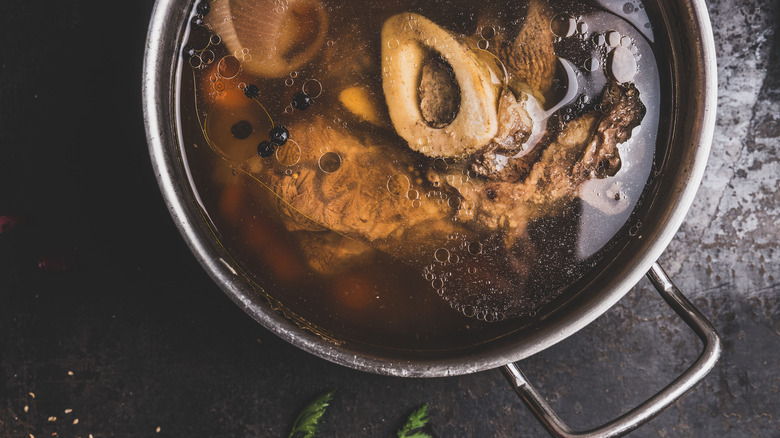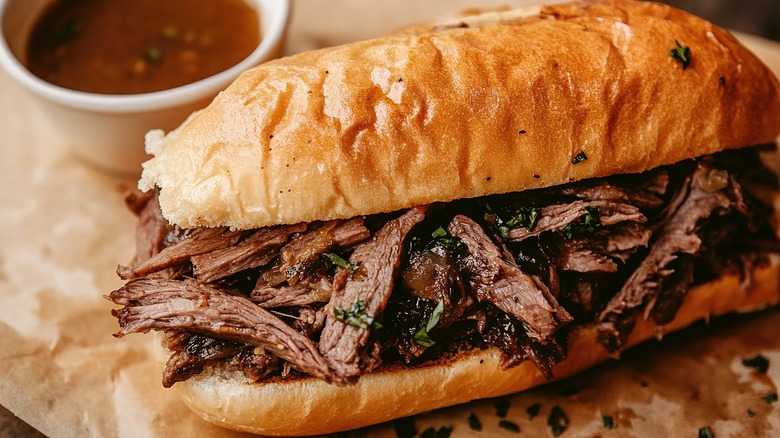Is There A Difference Between Beef Broth And Au Jus?
Despite it being an obviously French term, people in the United States are probably most accustomed to encountering "au jus" in one very specific context: It's the little dish of rich, brothy elixir that acts as the "dip" you get when you order a French dip sandwich. Which, by the way, is not particularly French. Invented in California, it's sometimes credited to a Los Angeles restaurant called Philippe the Original, whose owner, the titular Philippe Mathieu, claimed to have accidentally dropped a French roll in 1918 into a roasting pan filled with succulent meat juices. For the record, another LA restaurant, Cole's, also claims credit here — as with many culinary creations, the French dip's origins are contested (as is the ideal level of jus saturation on such a sandwich).
Despite the American-ness of all this, "jus" is a concept of French creation. It's the meat drippings left behind in a pan of, say, prime rib. "Jus" means, basically, "juice," so "au jus" translates literally as "with juice." Which means jus is completely different from beef broth, any other kind of broth, and broth's close cousin stock — broth and stock have more in common than whatever separates them, starting with the fact that they're both made from simmering meat, bones, and sometimes vegetables and other aromatics in water until the mixture becomes a steaming, delicious, fragrant broth or stock.
How beef broth is made
"Bone broth," made from beef or another animal, may have become super trendy in recent years, and for good reason: it's delicious and can be good for you. But it's also as old as time. Before the invention of cookware, ancient people might have made a version of broth by dropping searing stones into the stomachs of animals they hunted (yum).
Stocks and broths are pretty much universal — fish- and seaweed-based dashi, for instance, is essential to Japanese cuisine. But the beef broth you'll encounter in the U.S. is most closely related to European cooking traditions. In France, stock is known as the "fond," as in "foundation," as in the basis for everything else.
The French divide their fonds into different categories. Fond blanc often refers to stocks made with chicken bones; fond brun, by contrast — brown stock — is richer in both color and flavor and is made by first roasting meat bones (often veal) with vegetables in the oven before simmering them in water. With beef and other meat stocks, the chef's purpose is not only to extract flavor from the bones; it's to simmer them long enough that the collagen in the bones breaks down into gelatin, imparting a luscious, silky texture to the liquid. The stock then becomes the basis of soups, stews, braises, and other more elaborate dishes — or just something, these days, you can heat in a mug and take sips of.
The difference between broth (and stock) and jus
Okay, so: What's the difference between stock and broth? Really, it depends on whom you ask. Many folks use the terms interchangeably, though professionals — chefs and others — generally think of stock as being made from more bones than meat, and broth having a larger proportion of meat to bones. Which admittedly makes "bone broth" a slightly confusing term.
Jus, meanwhile, is just a completely different concept than stock or broth, notwithstanding that they're all liquid-y substances with meaty flavors. Classically, jus is made by scraping up the meat scraps and other bits clinging to the bottom of a pan that a roast has been cooked in — little bits of dense flavor also known in French cuisine as the fond. Just like making a pan sauce, chefs creating a jus deglaze the pan, which means dumping in wine, stock, or another liquid to help loosen up those bits and squeeze the flavor out of them. Then they strain the liquid to remove any pieces, skim off excess fat, and put it back on the stove, if necessary, to reduce it and further concentrate its intensity. Et voila: There's your jus.
As long as we're exploring distinctions, we'll note the fact that jus and gravy are separate things. Why? Jus isn't thickened; gravy, by contrast, starts with the same basic method, but is thickened with something like flour or cornstarch.


